Why would anyone care about how many Google Accounts exist in the world? It turns out that the number of active Google Accounts has knock on effects to website owners and internet marketing at large right around the world.
Many don’t realise it, however when you perform a search for [nike running shoes] on Google and most other search engines, click through to a website, the website you visit knows that you searched for [nike running shoes]. This isn’t anything malicious, deceptive or devious that Google or most other search engines are doing, it is part of how the internet has worked since the dawn of time.
Website owners can use the search phrase that a user typed to find their site to better understand their customers needs, improve their website content, tailor the user experience based on the phrase the user typed in, understand how different advertising interacts with one another and much much more.
Unfortunately, there is a prerequisite for the users query to pass across to the website in question – the user needs to have done a search on http://www.google.com and not https://www.google.com. Notice the addition of the letter s in https in the second Google URL, that signifies that Google is using Secure Socket Layer (SSL) to encrypt the connection between the user and Google, just like what internet banking websites use.
Google started providing encrypted search back in 2010 and while the connection between the user and Google was encrypted, through technical jiggery-pokery Google were still passing the users search query through to websites. In October 2011, Google made a change whereby users logged into their Google Account on google.com would be automatically switched over to HTTPS. In March 2012, Google announced that they were rolling that same change out globally through all of their regional Google portals such as www.google.com.au. Importantly, unlike the encrypted search product from Google that was driven by user security, the most recent changes are about user privacy and as such, Google isn’t using technical jiggery-pokery to pass the users search query through to websites and instead they get no keyword data at all.
Enter the unassuming Google Account, it provides a pathway into a vast array of Google products. Once a user logs into their Google Account, the user will remained signed into their Google Account until they specifically log themselves out of their Google Account. As such, as more and more Google Accounts are created, more and more users begin using Google secure search by default and website owners and internet marketers receive less and less search query data to help improve their websites and user experience with.
Microsoft Internet Explorer – Measurement Tool Of Choice
 Measuring how fast Google Account’s are growing without being on the inside of Google is a little tricky. No one network provider or ISP can see all traffic on the internet, which means that anytime someone outside of Google makes a claim about the size of Google or any other business on the internet – it is a guess, educated maybe but a guess none the less. Compounding that fact is that if a user has a Google Account, there is a good chance that they’ll be logged into it – which means that the users internet traffic is encrypted between them and Google, making it a little harder again for network providers or third parties to provide an accurate figure.
Measuring how fast Google Account’s are growing without being on the inside of Google is a little tricky. No one network provider or ISP can see all traffic on the internet, which means that anytime someone outside of Google makes a claim about the size of Google or any other business on the internet – it is a guess, educated maybe but a guess none the less. Compounding that fact is that if a user has a Google Account, there is a good chance that they’ll be logged into it – which means that the users internet traffic is encrypted between them and Google, making it a little harder again for network providers or third parties to provide an accurate figure.
Under normal circumstances I’d be one of the first to knock Microsoft Internet Explorer as a browser, it is slow to load, slow to render, not that great on memory consumption, is prone to crashing, most versions aren’t web standards compliant and it doesn’t provide an ecosystem of plugins in the same way that other more modern browsers like Firefox or Chrome do. However I’m actually happy that Internet Explorer is a slow moving beast in this instance, as it makes measuring how fast Google Account are growing possible.
When Google announced that users signed into their Google Account would use HTTPS by default, it signaled a changing of the tides; Google was going to begin moving more and more Google products over to HTTPS. It was now but a matter of time before other businesses and vendors began using Google secure search around the world.
Internet marketers worst fears were realised when Firefox 14 announced that it’d moved the search box over to Google secure search in July 2012. Later Apple released iOS6 in September 2012 which also defaulted the Safari browser to use Google secure search by default. Most recently, Google Chrome announced that when version 25 is released shortly it will move searches in the omnibox over to Google secure search as well.
Important among the announcements above, each of those browsers are using Google secure search whether the user is logged into their Google Account or not. As such, it isn’t possible to discern through web analytics packages whether a Firefox user is logged into their Google Account or if they’ve simply performed a search in the latest version of Firefox.
Fortunately, Microsoft haven’t enabled Google secure search by default yet, which makes it a good measurement tool. That doesn’t mean that some users of Internet Explorer don’t manually use the HTTPS version of Google search, which would skew the numbers a little but I don’t think it’d be significant enough to break the trend.
Astute readers may be wondering why not produce a complex analysis of different browsers and browser versions, trying to capture the largest percentage of traffic to perform the analysis on? The answer for that is straight forward, the growth rate of Google Accounts in browsers other than Internet Explorer is even higher, which I put down to the users being more internet savvy due to the fact that they aren’t using Internet Explorer and probably have a higher likelihood to have a Google Account as a by product of that. As such, as Firefox and Chrome continue to eat market share from Internet Explorer – it is reasonable to assume that the growth rate will accelerate even faster.
Measuring Google Account Growth With Google Analytics
What I’ve proposed below won’t tell you how many Google user accounts exist as an absolute number but it does provide a guide as to how fast Google Accounts might be growing in the wild.
To do this you’ll want to create two Google Analytics Advanced Segments:
- Source Google, Medium Organic, Browser Internet Explorer
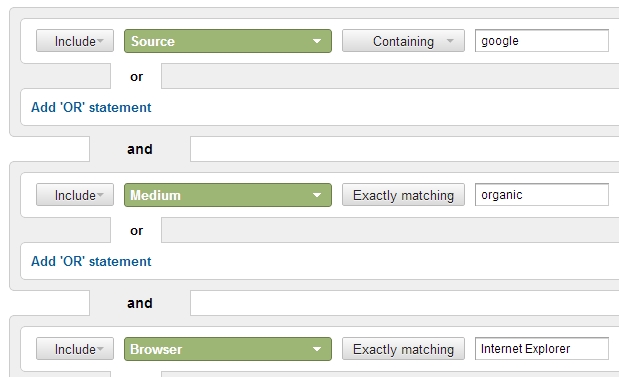
- Source Google, Medium Organic, Browser Internet Explorer, Keyword (not provided)
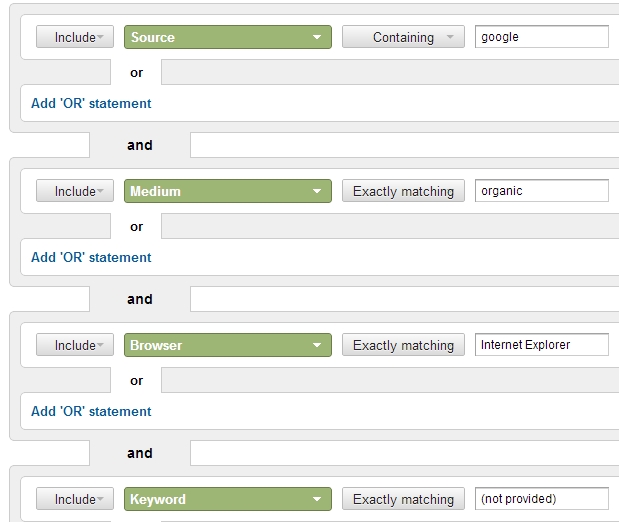
Enable both of the newly created Google Analytics Advanced Segments, pick a date range from January 2012 until present and use weekly data points to smooth out the graph a little.

Use the Google Analytics Export feature and export the current view into a format you’re happy to work with in your spreadsheet application, I chose CSV but use whatever works for you. The way the data is exported from Google Analytics isn’t quite what we need, with a row for each weekly data point per advanced segment:
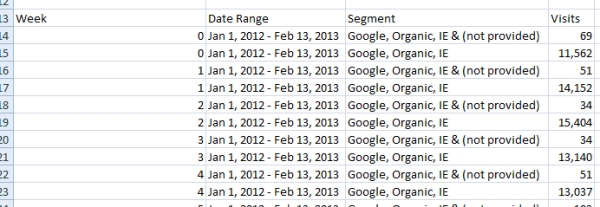
In the below screenshot you can see I’ve done three changes to help with data formatting:
- used a function to copy the values from the “Google, Organic, IE” rows into a new column
- added a new column showing the percentage of Google, Organic, Internet Explorer, (not provided) against Google, Organic, Internet Exploer
- filtered the Segment column and turned off Google, Organic, IE since the values are now in a new column thanks to point 1 above
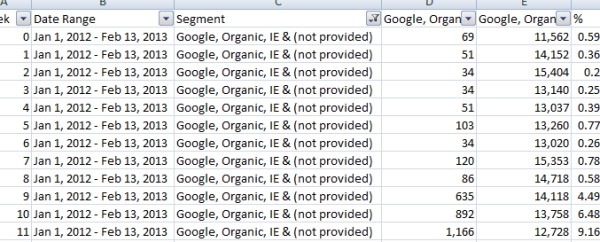
Highlight the two Google Analytics Advanced Segment columns and the percentage, chart them in Excel and you’ll quickly see the growth rate of Google Accounts for the audience relevant to that particular website.
In the graph below the purple line represents the percentage of (not provided) keyword against the total organic visits. You can see that in March 2012 when Google rolled out Google secure search globally that the percentage was at around 7% and toward the end of the 2012 and into 2013 you can see that it has climbed over 14%.
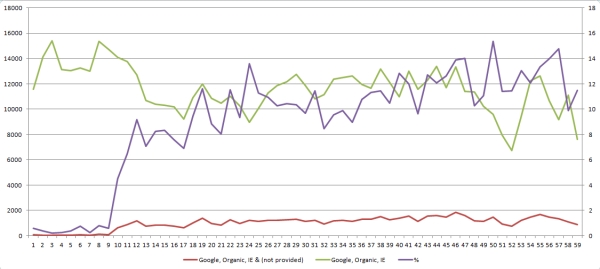
Does the above graph showing the growth of Google Accounts mean that Google Accounts have actually doubled, no it doesn’t directly. It could also mean that the total number of Google Accounts remained unchanged and twice as many people started using their Google Account. Of course bother of those scenarios are equally unlikely and more likely is the steady growth of (not provided) above represents a combination of both Google Account growth and potentially that interface changes and the push of Google+ is driving higher levels of Google Account usage.
If the trend above holds over 2013, website owners and internet marketers are set to lose more keyword data from their web analytics packages through natural growth of Google Accounts. Of course rate at which the growth in Google Accounts impinges internet marketing efforts will be insignificant compared to Google Chrome switching over to Google secure search on the next update and the inevitability of Internet Explorer receiving an upgrade in a future service pack that uses Google secure search by default.
Do you have a no keyword internet marketing analysis strategy in place yet?

Great article. I will have to agree that the not provided will continue to grow along with new Google accounts. With all of the integration between Google products makes it more likely that this number will grow.
It is a shame that we will lose so much search data in Google Analytics because all logged in users that search through Google will show up as (not provided).
It’d be amazing to know what impact recent changes in the user interface throughout many Google web properties has had on the signup rate and ongoing usage. For example, the new black bar at the top of Google draws your eye to it & if you don’t have a Google Account, the signup/login is more prominent than it was in the past.
Another interesting point I think is that as a result of Google+ being available across many of the Google websites now, users that might have logged in/out regularly are going to progressively become less likely to log out because it is very convenient to be able to receive notifications & comment on those when not in Google+ directly.